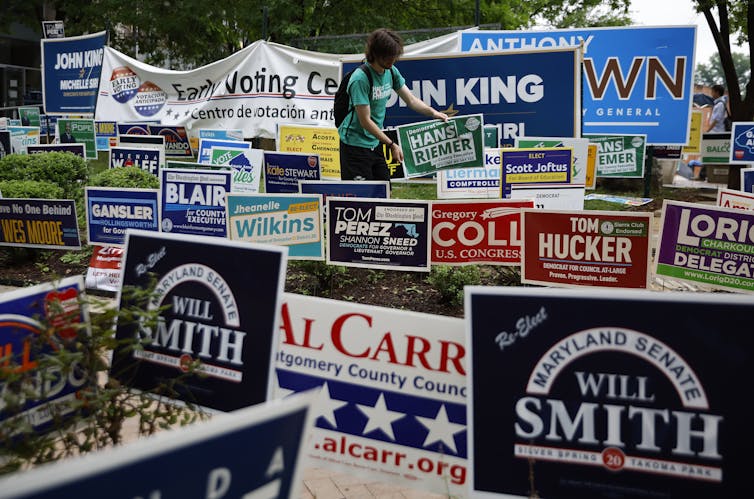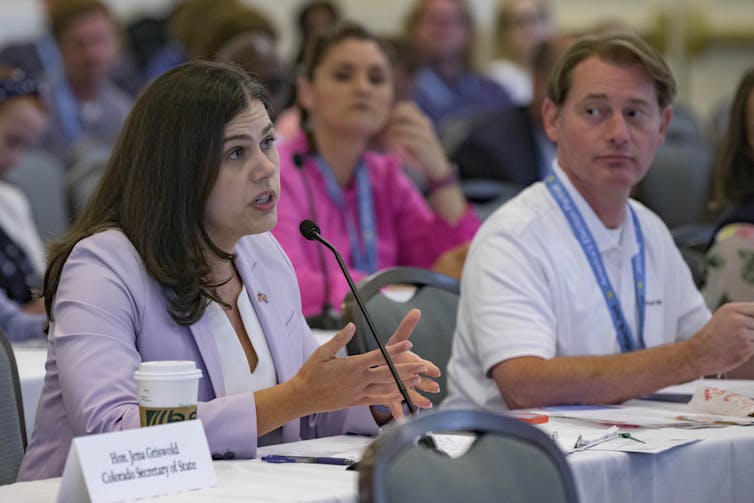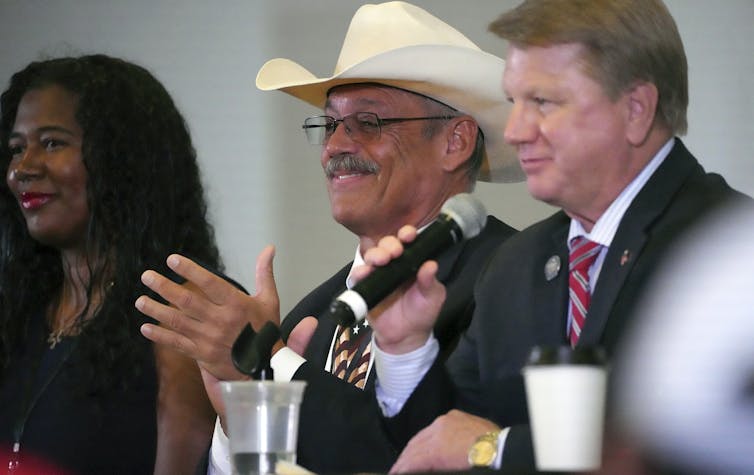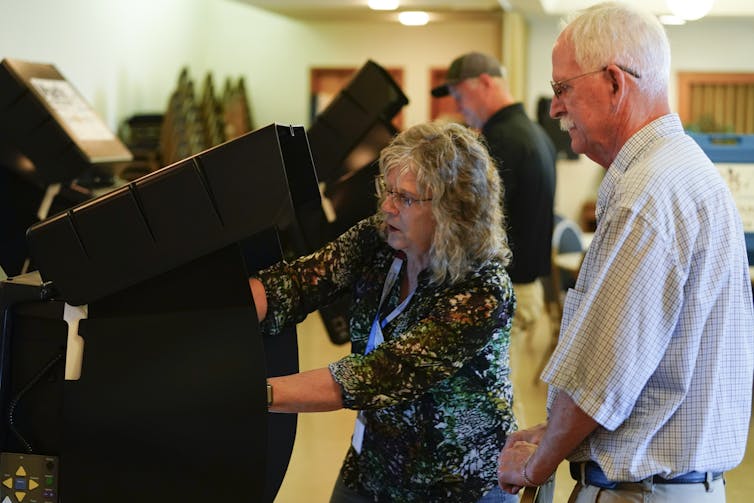Not anymore
Thom Reilly, Arizona State University
 |
| Candidate signs during the first day of early primary voting on July 7, 2022, in Silver Spring, Md. Chip Somodevilla/Getty Images |
That distrust is built largely on the widespread – and false – assertion that Donald Trump was re-elected in the 2020 presidential election, and that Joe Biden’s win was based on fraud.
Despite the 2020 election being the most secure in American history, and the courts and U.S. Department of Justice uncovering no evidence of widespread voter fraud that could change the outcome, consistently about 70% of Republican voters suspect election fraud, and overall mistrust in the neutrality of the election process remains high.
In some states, this has prompted the passage of voting restrictions and legislation aimed at interfering with the administration of elections. Legislation passed in various states has changed rules on how voters cast ballots, reduced the role of state chief election officials and shifted some aspects of election administration to partisan bodies.
As a scholar of public governance and a former local government official, I believe that there’s trouble ahead for the bedrock institution of U.S. democracy: elections. U.S. elections long relied on the good faith of the public, the nonpartisan behavior of election officials, as well as a two-party system of political checks and balances to ensure the legitimacy of results.
Now, the public’s mistrust of elections is combining with changes to election law and a major voter shift away from party affiliation to endanger the integrity of those elections.
 |
| Colorado Secretary of State Jena Griswold talks to her colleagues on July 8, 2022, at a national conference about threats that had been made against her. The previous month, a man pleaded guilty to making death threats against Griswold. Matthew Hinton/AP Photos |
50 ways to run an election
The administration of elections in the U.S. is a decentralized and complex system that gives considerable authority to state and local officials.
At the local level, election administrators determine who can vote, where they vote and how they vote. At the state level, election administration covers a range of logistics, including maintaining the statewide voter registration file and ensuring state and federal election laws are followed.
The result is that no state administers elections in exactly the same way, and there is variation even within states.
Additionally, the U.S. is one of the few democracies in which partisans run the election administration system.
That partisan system largely worked until now because, in essence, each party checked the other party’s ability to influence election outcomes. As long as states were politically diverse, members of the two major parties acted in good faith, and this model functioned – albeit imperfectly.
In my new book, “The Independent Voter,” my colleagues Jacqueline Salit, Omar Ali and I explore this U.S. partisan election system, whose nature has changed now that 25% to 50% of the voting population in each state is not affiliated with a major political party. That means one quarter to one half of the voting population in each state is shut out from playing a role in, or being represented by, any aspect of election administration.
This puts election administration into the hands of an increasingly partisan set of officials.
Public trust has eroded
The U.S. is the only democracy in the world that elects its election officials, and one of the very few to allow high-ranking party members to lead election administration.
The selection process for each state’s chief election officials can itself undermine trust in our election system. Most state chief election officers, known as secretaries of state, are chosen through explicitly partisan processes, such as partisan elections or political appointment. They conduct highly partisan and polarizing election campaigns.
Then, if they win election, they are expected to be seen by the public as trusted, neutral arbiters of election information and the electoral process.
A new threat to the integrity of elections comes with the recent moves to exploit these partisan models. This is being done explicitly by attempting to assign supporters, poll workers and observers to disrupt voting centers, tamper with equipment or call voting procedures into question.
Further underscoring this partisan system, the research I co-authored with Jeremy Gruber, John Opdycke and Jacqueline Salit, in which we reviewed 30 states with partisan voter registration, found that 27 states gave preferential treatment to partisans wanting to serve on election boards or as poll workers. Additionally, nearly half gave preference to partisans wanting to serve as election judges.
The partisan control of election administration in the states now serves to erode public trust and intensify partisan gamesmanship, which in turn further erodes public trust.
 |
| Kristina Karamo, candidate for Michigan secretary of state, Mark Finchem, candidate for Arizona secretary of state, and Jim Marchant, candidate for Nevada secretary of state, discuss conspiracy theories about voting machines and discredited claims about the 2020 presidential election at a conference in West Palm Beach, Fla., on Sept. 10, 2022. Jim Rassol/AP Photos |
Another hurdle to ensuring the integrity of U.S. elections has emerged recently as a result of the retirement or resignation of election personnel, in part due to violent threats and related personal safety concerns.
Approximately 35% of local election officials are eligible to retire by the 2024 election.
A recent study found that 1 in 3 election officials feel unsafe because of their job in election administration, and nearly 1 in 5 indicated their lives had been threatened. Another poll found 1 in 5 local election officials say they are likely to resign before the 2024 presidential election.
Add the heavy workload and relatively low pay for many election officials to the harassment many are now experiencing, and it is unclear whether there will be an adequate pool of qualified talent available to replace them by the next presidential election. Job qualification and duties vary significantly across state and local election offices, with many of these positions requiring college degrees.
 |
| A poll worker helps a voter cast a ballot in the Kansas primary election at Merriam Christian Church on Aug. 2, 2022, in Merriam, Kan. Kyle Rivas/Getty Images |
Lies undermine trust
Lastly, widespread misinformation and disinformation on election administration is hobbling the ability of election officials to do their job and has created fertile ground for mistrust.
Former President Trump and other high-profile individuals have exacerbated this by continuing to promote false claims regarding the 2020 presidential election results. State and local election offices have launched efforts to counter inaccurate information; however, these efforts often fail to reach or convince many audiences.
Social media companies have often been slow in identifying these false claims on their platforms. And local election offices have minimal or no presence on these popular social media sites such as Facebook, TikTok and Twitter, missing the opportunity to correct misinformation and amplify accurate information to the large number of people who use these sources to get news and information.![]()
Thom Reilly, Professor & Co-Director, Center for an Independent and Sustainable Democracy, School of Public Affairs, Arizona State University
This article is republished from The Conversation under a Creative Commons license. Read the original article.